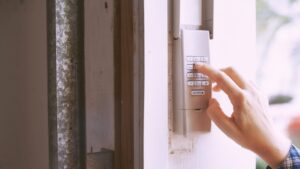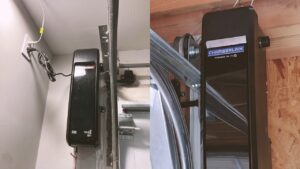As a homeowner, it’s crucial to have a basic understanding of garage door terminology. This can help you communicate effectively with professionals when you need repairs or maintenance and give you a better understanding of how your garage door functions.
This article will explain some of the most commonly used terms regarding garage doors, including types of doors, parts, and features. By understanding these terms, you can better understand your garage door and how to care for it properly.
Components of a Garage Door
The garage door is integral to most homeowners’ structure and aesthetics. As such, it’s essential to know all the parts that make up a standard garage door when you need to perform maintenance or troubleshoot any issues that may arise.
Here are some of the crucial components of a garage door.
Motors
Direct drive opener: A direct drive opener is a garage door opener that uses a motor to move the door directly without using other mechanical components such as belts, chains, or screws.
Chain drive opener: A chain drive opener is a garage door opener that uses a chain to transfer power from the motor to the garage door.
Screwdriver opener: This garage door opener uses a rotating screw to move the door.
Belt drive opener: A belt drive opener is a garage door opener that uses a belt to transfer power from the motor to the garage door.
Jackshaft opener: Jackshaft opener is mounted to the garage door wall rather than the ceiling above the door.
Springs
- Extension springs: Mechanical devices that store energy and provide a force when stretched or pulled.
- Torsion springs: Torsion springs are mechanical devices that store energy and provide a force when twisted or rotated.
- Torque Master springs: These are a type of extension spring specifically designed for use in the anatomy of a garage door.
- Galvanized steel springs: Galvanized steel springs are extension or torsion springs coated with a layer of zinc to protect them from corrosion. This makes them more durable and longer-lasting than uncoated steel springs.
- Oil-tempered springs: Oil-tempered springs are extension or torsion springs that have been heat-treated with oil to increase their strength and durability.
- Powder-coated springs: Powder-coated springs are extension or torsion springs coated with a layer of dry, powdered paint.
Garage Door

- Hinges: Hinges are mechanical devices that allow two objects, such as doors or windows, to pivot or rotate around a fixed point.
- Handles: Grips or levers used to hold or manipulate objects.
- Locks: Mechanical or electronic devices used to secure doors, windows, or other objects.
- Reinforcement struts: Structural elements that provide additional support or stability to a structure.
- Header brackets: Header brackets are support structures that hold up the header in a building or other structure.
- Center support brackets: Support structures that hold up the center of a structure, such as a beam or a truss.
- Weather seals: Weather seals are rubber or silicone strips placed around the edges of a door or window to seal any gaps and prevent drafts, water, and other outdoor elements from entering the home.
- Top fixtures: This refers to the hardware located at the top of a sliding door or window.
- Bottom fixtures: The hardware is located at the bottom of a sliding door or window.
- Rail end caps: Rail end caps are pieces of plastic or metal placed at the ends of a door or window track to protect the track from damage and keep the door or window moving smoothly.
- Rollers: Small, wheel-like components that support and move a sliding door or window along its track.
- Tracks: Channels or guides that a sliding door or window moves along.
- V-groove wheel: A v-groove wheel is a roller used on sliding doors or windows.
Garage Door Opener
- Limit switches: Limit switches are electronic devices that limit the movement of a motor or other mechanical system.
- Universal receiver: A universal receiver is a device that receives and transmits wireless signals. You can find it in automated doors and window systems to allow the doors or windows to be opened or closed using a wireless remote control or keypad.
- Motors: Motors are electric devices used for mechanical power systems such as doors, windows, and appliances.
- Wireless keypad: A device used to enter a code or password to unlock a door or other secure access point.
- Safety reversal system: A safety reversal system is a safety feature used on automatic doors and gates.
- Light kits: Sets of lights used to illuminate a door or window system.
Accessories
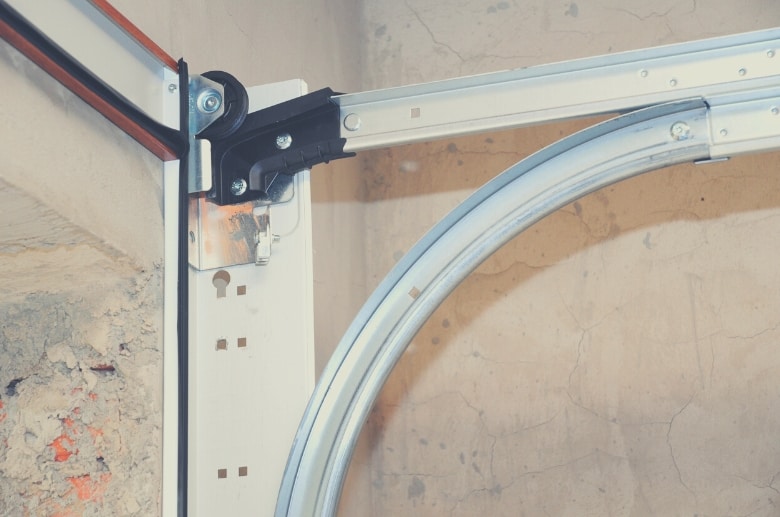
- Stainless steel roller track: This type of track or guide is made of stainless steel and used to support and guide the movement of objects, such as doors or conveyor belts.
- Nylon roller bearings: These are made of nylon and are used to reduce friction and allow for smooth, low-resistance movement of objects.
- Roller brackets: Roller brackets support and mount roller tracks or conveyor belts.
- Lock bar/lock cables: A lock bar is a bar or rod used to secure a door or other object. Lock cables connect the lock bar to a locking mechanism, such as a latch or lock.
- Cable drums: Cable drums are cylindrical devices used to store wind cables, such as those used in lift systems or conveyor belts.
- Cables: Cables are long, thin strands of metal or other material that are used to transmit electrical power or mechanical force.
- Pulleys: Pulleys are simple machines that consist of a grooved wheel and a cord or rope that is used to transmit mechanical force.
- Wall bracket: A wall bracket is a support or bracket attached to a wall and used to hold or support an object, such as a shelf or a light fixture.
- Motor units: Motor units are devices that use electrical energy to generate mechanical force or motion.
- Safety sensors: Safety sensors are devices used to detect the presence or absence of an object and trigger a response, such as stopping a machine or activating an alarm.
- Control panel: A control panel contains switches, dials, or other controls that allow a user to operate a machine or system.
- Keypads: Keypads are panels containing buttons that can be pressed to input data or control a device.
- Transmitters: Transmitters are devices that transmit signals wirelessly to a receiver.
- Manual release handle: A manual release handle is a handle or lever that can manually release a lock or latch.
- Weather seals: These are materials used to seal gaps or joints to prevent the passage of air, water, or other elements.
- Bottom seal: A bottom seal is located at the bottom of a door or other object to prevent the passage of air, water, or other elements.
- Vinyl stops: Vinyl stops are devices used to stop a door or window from opening too far.
- Seals: Seals are materials used to seal gaps or joints to prevent the passage of air, water, or other elements.
Garage Door Terminology
A
A-Frame: This is a term used to describe the shape of the main parts of a door, which is made up of two vertical panels connected by a horizontal panel at the top.
Adjusting Cone (Winding Sleeve, Winding Cone): Adjusting cones, also known as winding sleeves or winding cones, are used to adjust the tension on the torsion springs of a garage door.
Angle-Mounted Track: This is the mounting of the track for a garage door on an angle rather than straight across. It’s done to accommodate a sloped driveway or other slopes on the garage floor.
Astragal: This is a molding or strip of material used to seal the gap between the two halves of a pair of garage doors.
B
Backroom: The backroom is the area behind the counter in a garage, typically where the mechanics and other staff work on the vehicles.
Booster Spring: A booster spring is used in a garage door to help balance the door’s weight and make it easier to open and close.
Bracket Mounted: Bracket mounted refers to any device or component mounted to a wall or other surface using brackets.
C
Cable clamps: Devices that secure and hold cables in place.
Cable safety device: A mechanism that prevents a garage door from closing if an object is in its path.
Carry-away posts: Vertical supports are used to hold up the weight of a garage door.
Center hinge: A center hinge is located in the center of a garage door panel.
Center lift cable: A center lift cable is a cable that runs from the center of a garage door to the top of the door and is used to lift the door.
Center stile: A center stile, also called a stile, mullion, or mutt, is the vertical framing member of a garage door panel.
Chain hoist: A chain hoist is a device used to lift heavy objects using a chain.
Contour track: A contour track is used in a garage door system that follows the door’s contour.
Corner brackets: Corner brackets are L-shaped brackets used to secure the corners of a garage door frame.
Counterweight: A counterweight is a weight used to balance the weight of a garage door.
Cycle: A cycle refers to the opening and closing of a garage door.
D
DASMA: The Door and Access Systems Manufacturers Association is a trade association that represents manufacturers and suppliers of garage doors, openers, and related products.
Dead Load: This is the door’s weight, including any materials or components used in its construction.
Double Car (DC): A double-car garage door is a large, two-panel door designed to fit a standard two-car garage opening.
Double Low Headroom Track: This type of garage door track system is designed for use in garages with limited headroom, allowing the door to open and close without hitting the ceiling.
Double Shaft: A double shaft garage door opener refers to an opener with two motor units, one on each side of the door, rather than a single motor unit in the center.
Duplex Spring: A duplex spring is a type of garage door spring consisting of two separate springs coiled together and mounted on the garage door.
E
Edge Hinge (Roller Hinge): A hinge located at the edge of a garage door panel allows the door to roll up and down along a track.
Electric Interlock: A device that prevents the garage door from opening or closing unless it is in the proper position or if certain safety conditions are met.
Electric Opener: A device that automatically opens and closes a garage door using an electric motor.
End Stile: The vertical frame members at the ends of a garage door panel.
Exterior Lock: A lock located on the outside of a garage door is used to secure the door when it is closed.
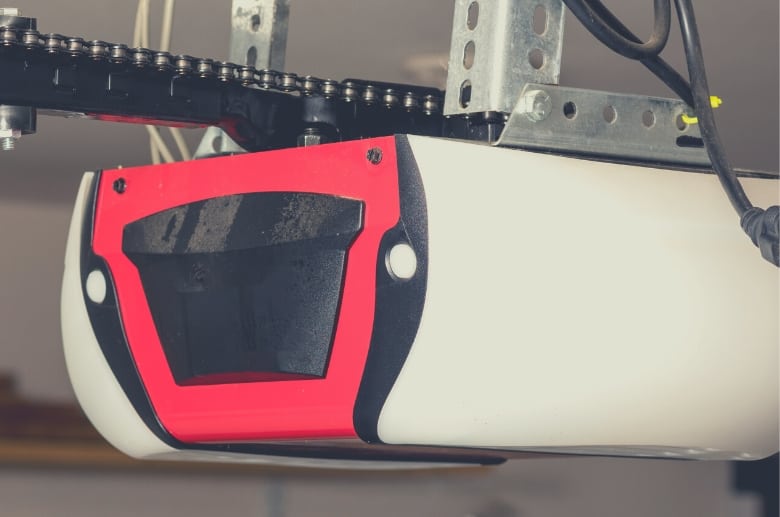
F
Ferrules: Ferrules are metal sleeves or caps used to reinforce or protect a hole or an end of a cable or wire.
G
GDO’s: GDO’s stand for Garage Door Openers, devices that allow users to open and close their garage doors remotely using a transmitter or smartphone app.
Graduated seal: A graduated seal is a type of weather stripping used to seal gaps around a garage door to prevent drafts and water from entering the garage.
H
Header Seal: This is a strip of weatherproof material attached to the top of the garage door to prevent water from entering the garage.
Headplate: The metal plate on the wall above the garage door supports the spring system.
Headroom: The vertical space needed above the garage door to operate correctly.
High Cycle Springs: Springs designed to withstand increased cycles (openings and closings) without breaking.
High Lift: A type of garage door installation that involves raising the door higher than usual to create additional headroom or to allow the door to clear taller objects, such as a lifted truck.
Horizontal Track Assembly: The system of tracks that the garage door rolls along when it is opened or closed.
I
IDA International Door Association: This is a professional trade organization for garage door and automatic door industries.
Inclined Track: Refers to a type of garage door track installed at an angle, typically used for doors mounted on the garage’s ceiling.
Inside Lock: A lock mechanism installed inside a garage door, typically used for added security or to prevent the door from being accidentally opened from the outside.
J
Jackshaft Opener: A jackshaft opener is a garage door opener that uses a horizontal shaft mounted on the wall to lift and lower the door.
A jamb Angle: It is also known as a jamb bracket. This is a metal angle or bracket installed on the sides of a garage door opener to support and stabilize the door.
Jamb Seal: A jamb seal is a weatherstripping or sealant applied to the jamb of a garage door to prevent drafts and water infiltration.
Joint Seal: A joint seal is a sealing material used to seal the joint between two panels or sections of a garage door to prevent leaks and ensure proper operation.
L
Lap jamb refers to the horizontal framing members at the sides of a garage door opening.
Lateral force: The force exerted on a garage door from the side affects the door’s balance and smooth operation.
Lift clearance: The amount of space above the garage door opening required for the door to fully open without hitting any obstructions.
Lite: A window or a panel of glass in a garage door.
Low Headroom: A situation where there is not enough vertical space above the garage door opener for the door to operate correctly.
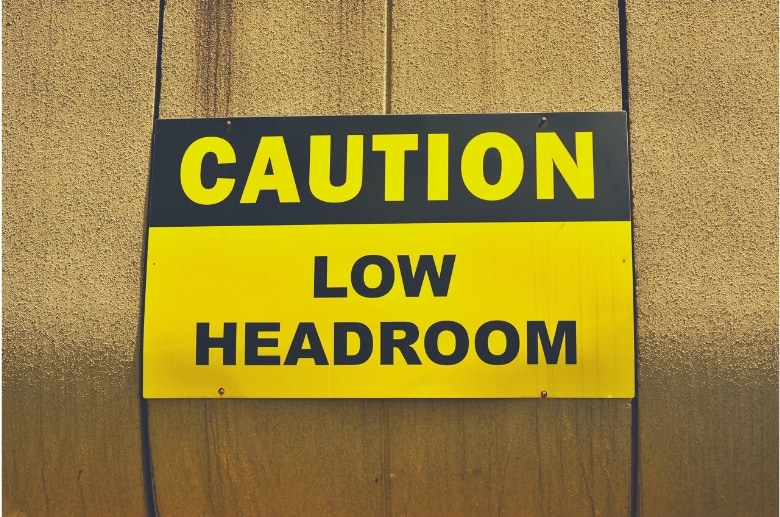
M
Metallurgist Report: A document prepared by a metallurgist, a specialist in the science of metals and their properties, detailing the results of testing or analyzing a metal or metal product.
Mill Certification: A mill certification is a document that provides information about the quality and characteristics of a batch of metal produced by a mill. This includes information about the metal’s grade, chemical composition, and other properties.
Mullion: A mullion is a vertical or horizontal bar that divides a window or other opening into smaller sections or separates adjacent windows or openings from one another.
N
Normal Headroom: This is the minimum amount of vertical space required above a garage door to allow it to open and close properly.
O
One Piece: This garage door type is made from a single panel that slides or swings open.
Open Back Door: A garage door with no backing or support on the inside, allowing for easy access to the garage from the outside.
Opener/Operator: A device that automatically opens and closes a garage door.
Opening: The opening refers to the space in which the garage door moves when it is opened or closed.
Opening Height: The distance from the floor to the top of the garage door opening.
Opening Width: Distance from one side of the garage door opening to the other.
Outside Hook-Up: The process of connecting a garage door opener to an external power source, such as a wall outlet or outlet box.
P
Panel: A flat, rectangular piece that makes up the surface of a garage door.
Pass Door: Small door located within or near a larger garage door. It typically allows people to enter or exit the garage without opening the door.
Perimeter Seal: A rubber or silicone strip attached to the bottom edge of a garage door.
Pocket Wheel: A small wheel mounted on a bracket and attached to the bottom of a garage door.
Push-Down Spring Bumper: A push-down spring bumper is a device that controls the tension in a garage door spring.
R
R-Value: Measure of thermal resistance used in the building and construction industry. A material can resist heat flow.
Radial Force: The force exerted by an object in a direction perpendicular to the radius of a circle.
Rollers: Small cylindrical wheels that are used to support and move objects. In garage doors, rollers are typically attached to the bottom of the door and ride along the tracks as the door opens and closes.
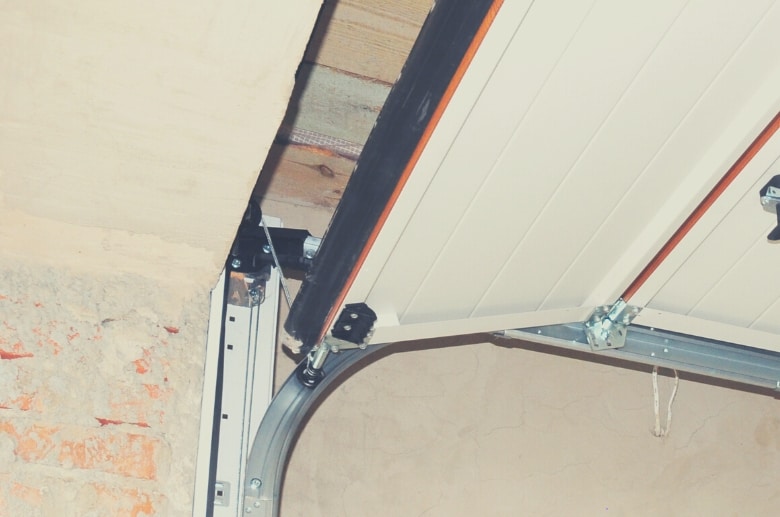
S
Sandwich Door: A garage door comprised of multiple layers or “slices” of material, with insulation between the layers.
Section: A piece or panel of a garage door typically made of steel, aluminum, or fiberglass.
Shaft Bearings: Small, cylindrical bearings that support the shaft of a garage door opener.
Sheaves: These are pulleys used in garage door systems to help lift and lower the door.
Side Bearing Plate (End Bearing Plate): A side bearing plate, also known as an end bearing plate, is a metal plate attached to the end of a garage door section.
Sideroom: The space on either side of a garage door is needed for the door to open and close properly.
Single Car (SC): A garage door that fits a standard one-car garage.
Spring Assembly: A spring assembly is a system of springs and other components used to lift and lower a garage door.
Spring Bumper: The rubber or plastic pad used to protect the garage door and surrounding walls from damage when the door is closed.
Spring Fittings: Hardware components that attach a garage door’s springs to the door itself.
Spring Pad (Center Bearing Plate): A spring pad, also known as a center bearing plate, is a metal plate used to support a garage door’s springs.
Stationary sleeves (spring retainers): These are metal sleeves attached to the static part of a garage door, typically at the top. They are used to hold the torsion springs in place.
Steel gauge: This is a measure of the thickness of a piece of steel. The lower the gauge number, the thicker the steel. For example, a steel gauge of 12 is thicker than a steel gauge of 16.
Stiles: These are the vertical frame members of a garage door. They are usually wood or steel and provide support and structure to the door.
Strut: This is a structural member used to support and strengthen a structure. In the context of a garage door, struts are typically used to reinforce the top section of the door, helping it to remain stable and secure when it is in the open position.
Swing-up post: This is a vertical support attached to the back of a garage door and helps hold it in the open position.
T
Tapered Vertical Track: This metal channel runs from the top of the garage door to the floor, and the door moves up and down when it is opened and closed.
Top Fixture: The hardware component attached to the top of the garage door helps to support the door’s weight as it moves up and down.
Torsion Shaft: The long, cylindrical rod that runs along the top of the garage door and helps to support the weight of the door as it moves.
Torsion Springs: Long, coiled springs that provide the tension needed to lift the garage door.
Track: The track is a metal channel that runs along the sides of the garage door and helps to guide the door as it moves up and down.
Trajectory: The path the door follows as it moves up and down.
Trolley Operator: A mechanical device used to open and close a garage door.
Truss (Struts): Trusses, also known as struts, are structural components that support the garage door’s weight and help keep it in place as it moves.
U
Upper Vertical Track: An upper vertical track is the uppermost section of the track system that guides the garage door movement as it opens and closes.
V
Vertical Lift: The term describes how a garage door opens and closes.
Vertical Track: A long, vertical piece of metal that is mounted to the wall of the garage and extends upward to meet the upper vertical track
W
Wind Load: The force of the wind on a structure, such as a garage door. The wind load rating of a garage door indicates how much wind pressure the door can withstand without damage.
Winding Sleeve (Adjusting Cone): A cylindrical piece of metal used to adjust the tension on the torsion springs of a garage door.
Final Takeaway
Being an informed homeowner is highly beneficial when taking care of your garage door and avoiding costly repairs. Familiarize yourself with the different parts of your garage door system.
You also need to learn how to perform basic maintenance tasks on your garage door. Keep an eye out for warning signs of a problem with your garage door. This may include loud noises, the door not opening or closing properly, or the opener not working correctly.
If you encounter a garage door problem that you can’t fix yourself, don’t hesitate to call a professional. A skilled technician can diagnose the issue and recommend the best action.



